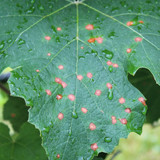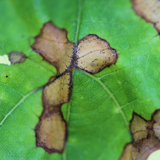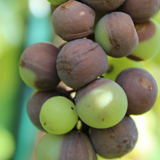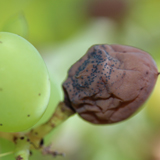Introduction to Black Rot
Black rot is the most severe disease of grape in the Midwest. Guignardia bidwellii favors rainy spring weather. Young tissue is most susceptible to infection.
Initial infections are caused during sporulation from overwintering fungi. If these spores are allowed to infect (i.e. fungicide program not implemented), secondary spores develop in scab lesions. These secondary spores are capable of producing thousands of new disease lesions. Thus, growers should focus on control of initial spring infections before secondary repeating spores can form.
Leaf infection
Leaf infections begin as small round, reddish-brown spots. As they enlarge to 1/8 to 1/4 inch diameter, margins darken while centers become lighter (Figure 1). Small black fruiting bodies develop in centers of spots (Figure 2). Leaves become resistant as they mature.
Stem infection
Shoot and petiole infections are irregular to diamond-shaped and somewhat sunken. They are tan-colored with small black fruiting bodies that can be seen with the naked eye (Figure 3). Stem lesions can serve as a source of fungal inoculum in spring.
Fruit infection
Fruit are susceptible to infection from bloom until 3 to 4 weeks after bloom (berry coloring). Infections begin as soft spots that rapidly enlarge (Figure 4). Affected berries turn black and shrivel into wrinkled mummies. These mummies are the primary overwintering structure for the fungus (Figure 5).
More information on black of grape can be found in publication PPFS-FR-S-16.
Spray recommendations for commercial growers
ID232
and homeowners
ID-21
are also available online.




Figure 1. Leaf infections begin as small round, reddish-brown spots.
Figure 2. Small black fruiting bodies develop in centers of spots on canes and leaves.
Figure 3. Fruit infections begin as soft spots which expand.
Figure 4. Spots rapidly enlarge to encompass the entire berry; small black fruiting bodies become evident.
Notes
Risk for black rot is highest from leaf emergence until 3 to 4 weeks after bloom.
Prediction model is based on leaf wetness duration and average temperature during wetness events.
Instructions
• Select county from drop-down menu using arrows.
• Select today’s date to determine current risk for black rot. Other dates may be entered if assessment of past risk is warranted.
• Determine vineyard history.
• Click 'submit choices'
These data are based on the 24 hour period 7PM to 7PM.
Data should NOT BE USED FOR LEGAL PURPOSES.